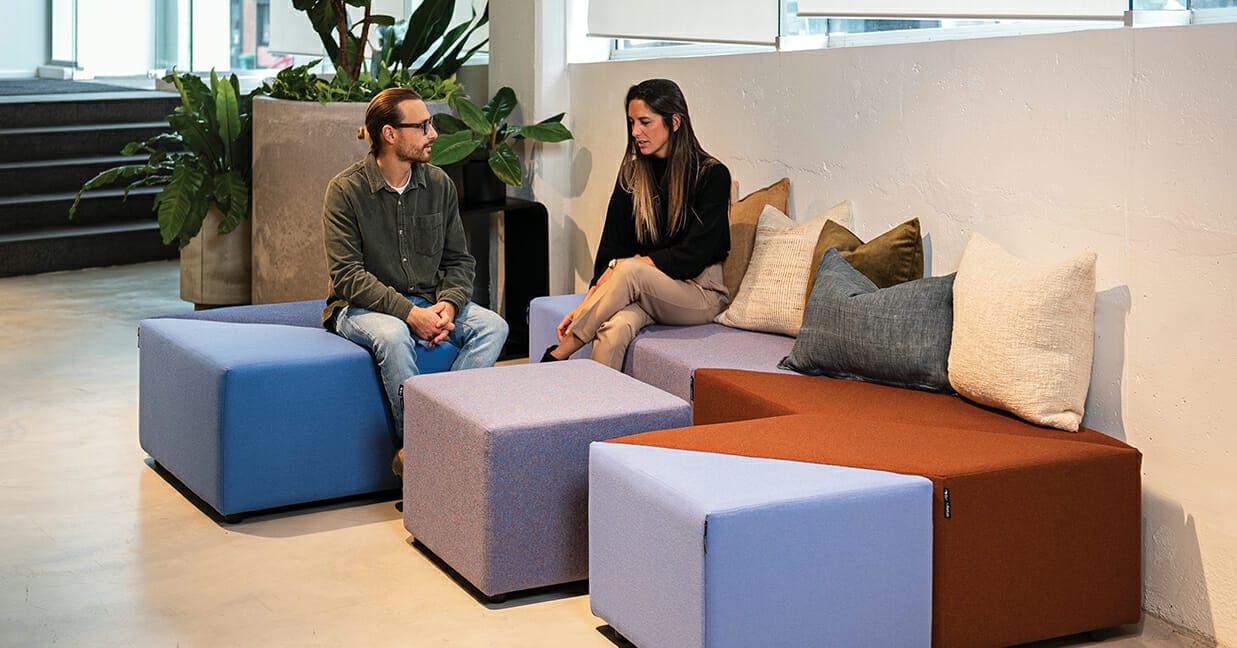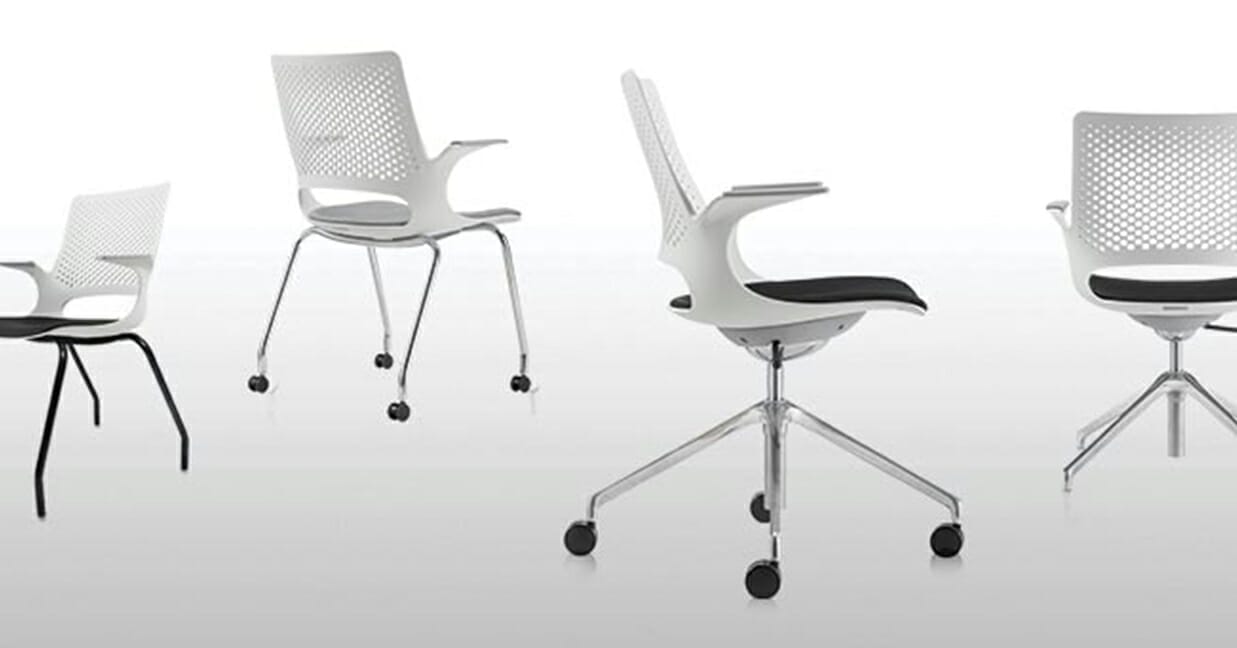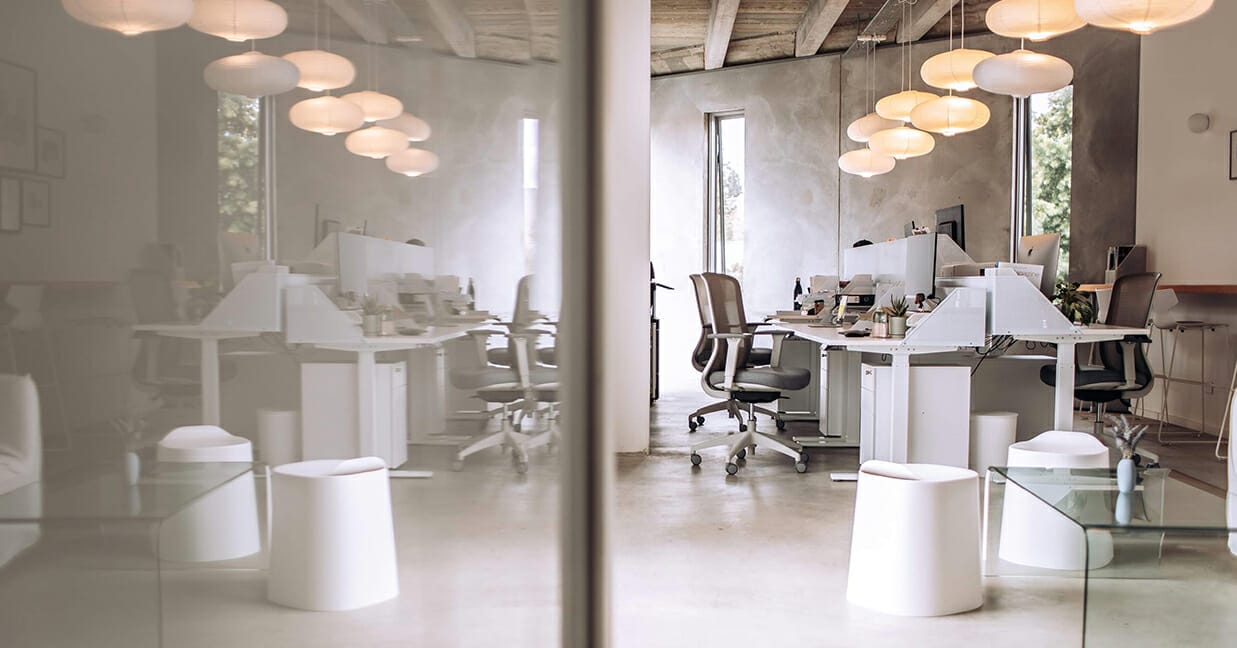In years gone by, most offices looked exactly the same no matter where you worked, with long rows of identical desks and office seating arranged in rigid banks.
Following the emergence of new technology and flexible working trends, the typical working day has changed, and the modern office needs to be much more flexible.
Employers are becoming more creative with their workplace furniture, offering staff a selection of office seating and desk options to maximise productivity and flexibility.
Having plenty of different office seating options can have a big impact on employee productivity and wellness. From ergonomic office chairs to active sitting stools, there are plenty of ways to ensure your workplace is comfortable — and conducive to great work.
In this blog, we’ll show you why having different seating options is a great idea, the different types of modern worker and how to cater for them, what an ‘office neighbourhood’ is, and the four main office design principles.
The benefits of diverse seating
Diverse office seating options can bring a number of benefits. Well-designed office desk chairs can reduce fatigue and discomfort, improve posture and ergonomics, and increase productivity.
Different office seating arrangements can also boost collaboration and productivity. For example, touchdown spaces can provide hot-desking employees with a place to work when they visit the office, or a dedicated spot for staff to team up on group projects.
As flexible working patterns become more common, more organisations are offering touchdown spaces for their employees to drop into.
Touchdown spaces need to be designed with adaptable furniture to support staff productivity. Take a look at our previous blog on touchdown spaces here.

Steelcase researchers found hybrid workers fell into three distinct categories; Anchored, Untethered and Destination.
The three different types of worker
Increasingly, employers recognise that office workers have unique needs depending on their jobs. Most of us these days don’t just work at a desk, we perform our tasks from a wide range of settings.
Here are the three different types of worker, according to office furniture designer Steelcase, and how their needs vary:
Anchored worker
An anchored worker has a fixed work place and works on a regular schedule. They perform their tasks in the same location, “anchored” to a specific physical space. Anchored workers are expected to be present at their workplace during specific hours and often have limited flexibility on where they can work.
Because they work mainly at their desk, anchored workers need somewhere to store their belongings and office equipment. They’ll also need to step away from their desk from time-to-time, so often need private breakout spaces.
Untethered worker
An untethered worker can work from anywhere, any time. They’re not tied to a specific location or workstation and can generally work where they want. An untethered worker could work from their home office on some days, in the office on others, or even from a cafe or co-working space.
When they come back to their employers’ HQ, untethered workers require unassigned team spaces to collaborate with other employees on projects. They require more flexibility, and the ability to work independently as well as collaboratively with others in the office.
Destination worker
A destination worker travels from place to place, working in set locations for short periods. They might work at a client’s office or on a construction site, visiting different sites each week as part of their role.
This kind of worker usually needs collaborative seating and furniture that can be arranged easily. They also need peaceful, private spaces to perform individual work and maintain their productivity.
Would you benefit from an office neighbourhood?
Are you ready to ditch fixed desks for good and go fully flexible? An office neighbourhood might be the perfect fit for your company.
Office neighbourhoods are becoming increasingly popular in the US. They are designed to help employees collaborate as one large group. Individual desks are scrapped in favour of agile-working spots and activity-based working spaces.
This kind of office setup works well for organisations that thrive on sharing ideas and group creativity. Think architects and designers sharing ideas, or creative copywriters and advertising account directors working together side by side.
Office neighbourhoods usually include hot-desking and activity-based workspaces. They also feature common facilities like lounges and kitchens, and shared resources like conference rooms, shared desks, and phones. Private offices are provided for employees who need a quiet place to concentrate.

The four different types of office space
According to Steelcase, the workplace has four foundational space typologies.
As you consider a more diverse office setup, here’s the low-down on the four different types of office space, and what furniture fits best.
Personal spaces
Personal spaces give employees total control over how they do their work, and act as a quiet spot to get on with tasks. Enclosed work booths give staff space and privacy to conduct phone calls and focus in-between meetings.
Collaboration spaces
Open plan areas are for employees to share ideas. Open collaboration spaces should come with different office seating options, such as stools, chairs, sofas and desks in order to get ideas flowing. You could also introduce a computer screen for remote collaboration.
Social spaces
Social spaces are designed to encourage a sense of community and improve team building and morale. Mix and match sofas, comfortable chairs, booths, desks and office desk chairs and allow employees to configure as they choose.
Learning spaces
Learning spaces are areas for staff to share ideas and inspire one another. The centrepiece of the room is often a big screen or whiteboard, with moveable stools, chairs and desks to huddle around.
Choosing the right furniture
Now you know all about the importance of diverse office seating, what kind of chairs are best for your organisation?
Here’s a breakdown of our best seating options and how they can bolster your business.
Ergonomic office chairs
As leaders in seating design, we have plenty of ergonomic seating options for your office.
Our Buro Seating brand covers all bases, linked by a common quality of ergonomically smart design that is durable, user-friendly, and certified to the highest international standards.
Buro’s ergonomic chairs deliver optimal comfort and high performance, preventing workstation injuries and ensuring your staff maintain excellent posture.
Soft seating
Soft seating can add lounge-like comfort to a breakout space for your employees to crack on with some brilliant team projects.
The Konfurb Eightby4 Series is great for agile offices and can be reconfigured to your tastes, while the Konfurb Star Family promotes creativity and communication.
Stools
Bar stools and desk stools can be a useful addition to your office, keeping staff engaged and comfortable. Check out our range of ottomans that are great for group work, and the Buro Polo Drafting stool, which promotes active sitting.
The classic Buro Polo Stool, meanwhile, is height adjustable and also promotes active sitting. Endorsed by the Australian Physiotherapy Association, this stool is easy to move around and encourages postural change, ideal for bustling group work environments and brainstorming sessions.
Visitor & meeting room chairs
It’s important to make a great impression on your visitors. That’s why it’s key to pick a smart and comfortable waiting room chair. Whether it’s style or functionality you’re after, there’s a wide selection of chairs to match.
Conference room chairs need to be a little more flexible and moveable than waiting room chairs. Options like the Konfurb Harmony Guest are easily configurable for weekly meetings or video calls.

The Konfurb Harmony Series chairs includes guest and computer chairs.
Ready to make your office seating more diverse? Check out Buro’s ergonomic, stylish and comfortable seating range for inspiration.




